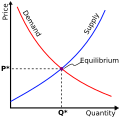
Back Gini-koëffisiënt Afrikaans معامل جيني Arabic Coeficiente Gini AST Cini indeksi Azerbaijani Каэфіцыент Джыні Byelorussian Каэфіцыент Джыні BE-X-OLD Коефициент на Джини Bulgarian गिनी गुणांक Bihari জিনি সহগ Bengali/Bangla Gini koeficijent BS

- <30
- 30-35
- 35-40
- 40-45
- 45-50
- 50+
| Part of the behavioral sciences |
| Economics |
|---|
 |
|
|
In economics, the Gini coefficient (/ˈdʒiːni/ JEE-nee), also known as the Gini index or Gini ratio, is a measure of statistical dispersion intended to represent the income inequality, the wealth inequality, or the consumption inequality[2] within a nation or a social group. It was developed by Italian statistician and sociologist Corrado Gini.
The Gini coefficient measures the inequality among the values of a frequency distribution, such as income levels. A Gini coefficient of 0 reflects perfect equality, where all income or wealth values are the same. In contrast, a Gini coefficient of 1 (or 100%) reflects maximal inequality among values, where a single individual has all the income while all others have none.[3][4]
Corrado Gini proposed the Gini coefficient as a measure of inequality of income or wealth.[5] For OECD countries in the late 20th century, considering the effect of taxes and transfer payments, the income Gini coefficient ranged between 0.24 and 0.49, with Slovakia being the lowest and Mexico the highest.[6] African countries had the highest pre-tax Gini coefficients in 2008–2009, with South Africa having the world's highest, estimated to be 0.63 to 0.7.[7][8] However, this figure drops to 0.52 after social assistance is taken into account and drops again to 0.47 after taxation.[9] Slovakia has the lowest Gini coefficient, with a Gini coefficient of 0.232.[10] Various sources have estimated the Gini coefficient of the global income in 2005 to be between 0.61 and 0.68.[11][12]
There are multiple issues in interpreting a Gini coefficient, as the same value may result from many different distribution curves. The demographic structure should be taken into account to mitigate this. Countries with an aging population or those with an increased birth rate experience an increasing pre-tax Gini coefficient even if real income distribution for working adults remains constant. Many scholars have devised over a dozen variants of the Gini coefficient.[13][14][15]
- ^ Haddad, Cameron Nadim; Mahler, Daniel Gerszon; Diaz-Bonilla, Carolina; Hill, Ruth; Lakner, Christoph; Ibarra, Gabriel Lara (17 June 2024). "Inside the World Bank's new inequality indicator: The number of countries with high inequality". World Bank. Retrieved 25 October 2024.
{{cite web}}: CS1 maint: multiple names: authors list (link) - ^ "Glossary | DataBank".
- ^ "Current Population Survey (CPS) – Definitions and Explanations". US Census Bureau.
- ^ Note: The Gini coefficient could be near one only in a large population where a few persons have all the income. In the special case of just two people, where one has no income, and the other has all the income, the Gini coefficient is 0.5. For five people, where four have no income, and the fifth has all the income, the Gini coefficient is 0.8. See: Bellù, L.G. and Liberati, P. 2006. Inequality Analysis: The Gini Index. EASYPol: Resources for policy making. Rome, FAO.
- ^ Gini, Corrado (1936). "On the Measure of Concentration with Special Reference to Income and Statistics", Colorado College Publication, General Series No. 208, 73–79.
- ^ "Income distribution – Inequality: Income distribution – Inequality – Country tables". OECD. 2012. Archived from the original on 9 November 2014.
- ^ "South Africa Snapshot, Q4 2013" (PDF). KPMG. 2013. Archived from the original (PDF) on 2 April 2016.
- ^ "Gini Coefficient". United Nations Development Program. 2012. Archived from the original on 12 July 2014.
- ^ Schüssler, Mike (16 July 2014). "The Gini is still in the bottle". Money Web. Retrieved 24 November 2014.
- ^ "World Bank Open Data". World Bank Open Data. Retrieved 9 May 2023.
- ^ Hillebrand, Evan (June 2009). "Poverty, Growth, and Inequality over the Next 50 Years" (PDF). FAO, United Nations – Economic and Social Development Department. Archived from the original (PDF) on 20 October 2017.
- ^ Cite error: The named reference
undp10was invoked but never defined (see the help page). - ^ Yitzhaki, Shlomo (1998). "More than a Dozen Alternative Ways of Spelling Gini" (PDF). Economic Inequality. 8: 13–30. Archived (PDF) from the original on 3 August 2012.
- ^ Sung, Myung Jae (August 2010). "Population Aging, Mobility of Quarterly Incomes, and Annual Income Inequality: Theoretical Discussion and Empirical Findings". Korea Institute of Public Finance. CiteSeerX 10.1.1.365.4156.
- ^ Cite error: The named reference
blomq81was invoked but never defined (see the help page).